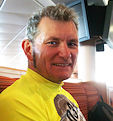I love to cycle in northern France and have done so many times over the years. The roads are wonderful, the people (in my experience) warm, friendly and generous. It's easily accessible from the UK, not too hilly, has beautiful countryside and is full of wonderful architecture and history. So, when I had the opportunity to explore more of the region courtesy of the Tour de Manche, I leapt at the chance.
The Tour de Manche (La Manche, of course, is French for what we rosbifs call the English Channel) is a project to develop a continuous, 745-mile cycling route connecting parts of Normandy, Brittany, Jersey and southwestern England. Historically and geographically, the regions are very similar; the villages and towns around Granville and Erquy could easily be mistaken for their counterparts in the picture-postcard valleys of Dorset and Devon, with only the absence of scones giving the game away.
The Tour de Manche will launch officially in 2015, the culmination of years of cooperation between councils and authorities either side of the water to develop and improve existing routes and build new facilities to support the boom in leisure cycling across the regions. To mark the launch I was invited to ride a sample of the route and report back - and, I'm happy to say, I found plenty here to satisfy cyclists of all persuasions.

Au revoir, race bike
As a road cyclist used to travelling light, I was a bit apprehensive about what I would experience. I had to leave my trusty road bike behind in England and climb aboard a hired hybrid for a start. We would be cycling only selected sections of the route on our whistlestop tour, but enough, I hoped, to get an overall impression of what you can expect to encounter on a more leisurely visit.
So: four days, three different countries, a miasma of contrasting scenery and a fleet of borrowed bikes, boats and buses awaited...how did it all pan out?
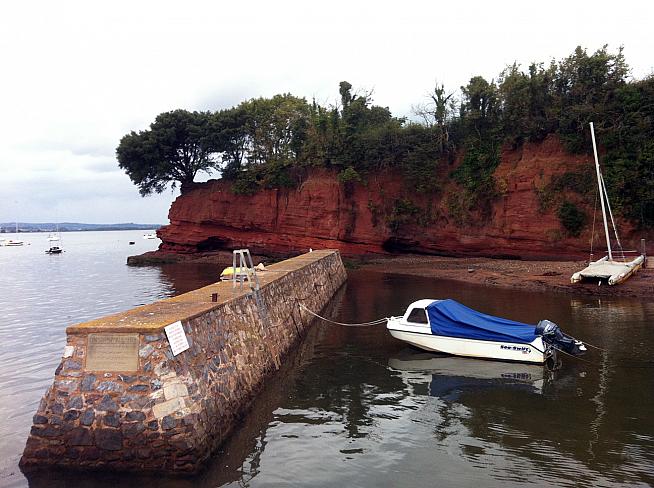
It was a pleasure to awake on my first morning in the picturesque coastal town of Erquy, looking north over a calm bay with the mist just lifting from the Channel. The previous evening, I'd had a delicious meal hosted at one of the many excellent quayside restaurants. The Brittany coast is famous for its seafood, especially scallops, and we were keen to try the local "Kir Breton". This is a mix of cidre and cassis - a Gallic version of cider & black - and as we were to discover it is popular throughout this region of northern France. The small and friendly hotel, the Beausejour, was quiet and comfortable despite being next to the main road through the village. Thankfully, I managed to negotiate breakfast with my embarrassingly inadequate schoolboy French without noticeably upsetting the manageress or guests.
Duly fitted to my hire hybrid, organised through Rennes-based French cycle touring specialists Abicyclette, I joined my group of fellow visitors. Accompanied by a couple of local travel reps to help us navigate towards Cap Fréhel, we set off on the modest ride of about 15km.
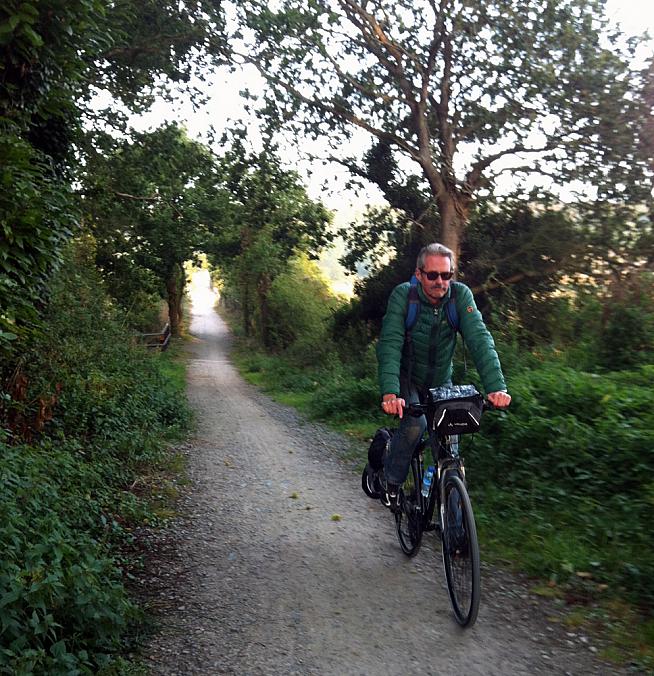
Our group consisted of a couple of English, two Germans, three Dutch and two Belgians from various journalistic backgrounds. Some were here for a tourism experience; others, like me, were making the journey to experience regions from a cycling perspective. Harald from Cologne was keen to find out more about the Channel Islands as a potential holiday destination, while Jessica, a photojournalist from The Hague, was more interested in the beauty and contrast of the landscape.
Off we set en masse on the first leg of our tour. I was surprised that we left the main road quickly and went up a narrow farm track, but this soon opened out onto a wider path of crushed sandstone. The morning was still misty so we cracked on to keep warm, but soon came to a brand new raised boardwalk with stunning views over a marshy meadowland.
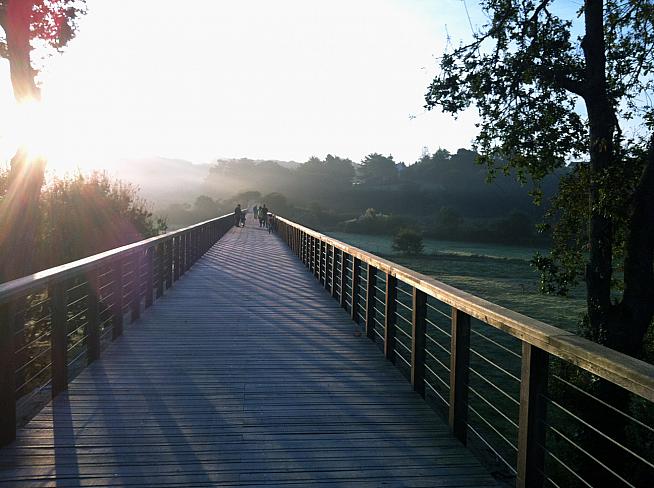
As we rejoined the main road we saw the first of many local cyclists speeding by, united in their Sunday morning efforts by matching kit and heads down determination. Cyclists of every age whizzed past astride gleaming racing bikes, all splendidly coordinated in local club regalia. For a moment I felt a pang of jealously, resentful of the rougher roads I was on and the sluggishness of my fat tyres, but I was seeing parts of the landscape a racing geometry often misses.
After a brief stop to top up with water from Fabien in our support vehicle we headed up some short but challenging climbs to the final point of the morning's ride, the lighthouse at Cap Fréhel. Its elevated position offers panoramic views over the cliffs and the Gulf of St Malo, but there was no time to linger: we had to dash to St Malo to catch a ferry to Jersey.
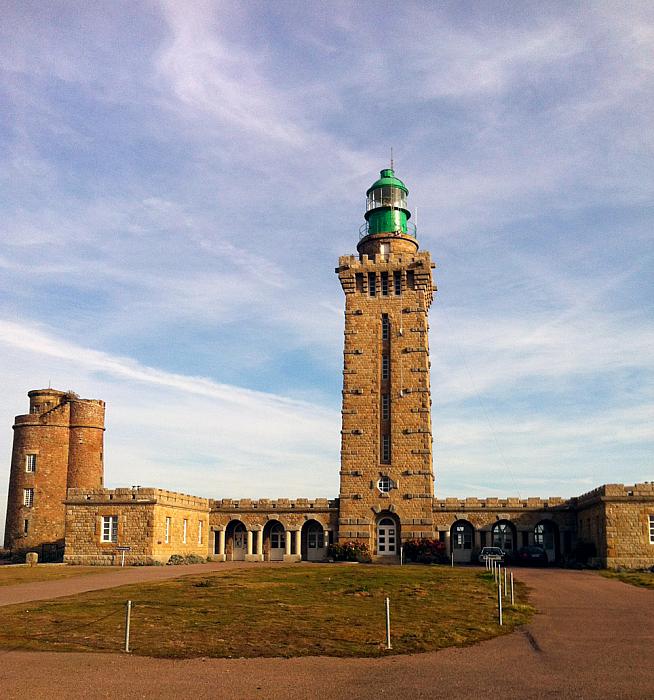
Jersey shore
Travel between the French mainland and the Channel Islands is quick - crossings can take as little as 90 minutes, and departures are frequent. Our Condor Ferries ride was very comfortable indeed, with plenty of on-board amenities for shopping and eating considering how compact it was. At the port of St Hellier we were met by a local guide and taken to one of the two bicycle hire companies in the capital.
Jersey is a fascinating place, the largest of the Channel Islands, all of which are part of the United Kingdom, but are each fiercely individual. Jersey itself has a rich and varied history, pledging allegiance to the once Duke of Normandy, King John, and maintaining that loyalty to each successive monarch of Great Britain right the way up to Queen Elizabeth II.
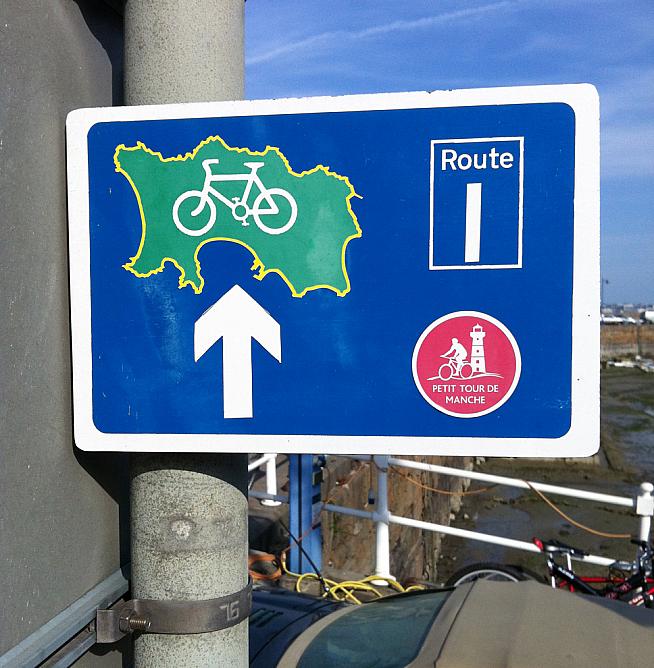
The way of life is very British, in a coastal retirement town sort of way, with English currency but French laws. It has been a centre for shipbuilding and trade, and lately commerce and tourism. Jersey was occupied by German troops between 1940-1945, and the wartime construction that took place on the island due to its strategic importance is plain to see; in fact, evidence of Jersey's importance stretching back many centuries remains in the castle and crenelated strongholds that dot the coastline.
One legacy of the 1940s was the preservation of the island's railway, the line of which stretches from St Hellier almost to the western tip of the island at Corbiere. It was shut down in the late 1930s and renovated by the Germans for use during the war and after. However, these days cars outnumber the resident population on the island, and the now defunct rail route has been converted to a cycle path. The result is that this disjointed section of La Tour de Manche is very comfortable for two-wheeled travellers, the wide and well signposted routes proving popular not only with cyclists, but with runners and others out enjoying a stroll.
There are over 60km of cycle routes on Jersey, and plenty of accommodation options to cater for visitors. Adjacent to the lighthouse at Corbiere, a refurbished wartime observation post now serves as luxury holiday accommodation, one of many such conversions. After a brief stop for ice cream and a view across the Atlantic towards Newfoundland, some 3500km away, it was time to go.
Back to the ferry port, where we bid adieu to our guide and the functional, frill-free hire bikes for another short jaunt back to the mainland. The crossing this time was on the Manche Iles Express, an island hopper ferry for the short cruise to Normandy.
Granville rendezvous
We spent the night in the bustling seaside town of Granville, birthplace of fashion KOM Christian Dior. The next morning we set out for a 10km cycle next to the Couesnon River to its estuary and the famous Mont-Saint-Michel. The river serves as a boundary between Brittany and Normandy and has benefitted, courtesy of the Tour de Manche project, from the construction of a new bridge halfway between Pontorson and Saint-Michel, the existing bridge being unsuitable for cyclists due to the volume of traffic that uses it.
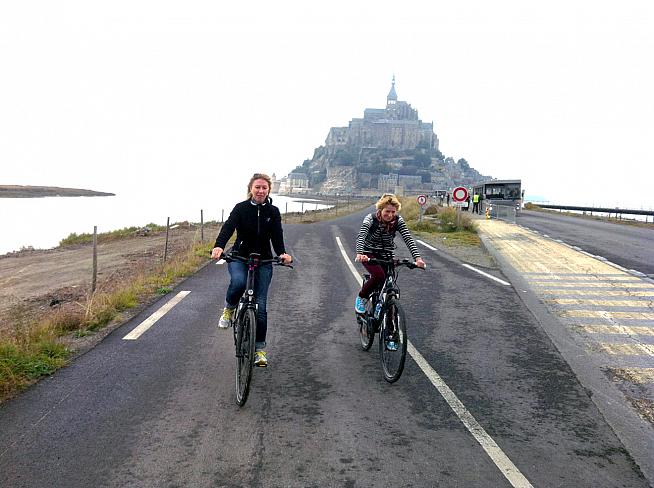
There is also a new dam close to the mouth of the estuary, built across the river to help alleviate the silting that has been threatening to rejoin the island of Mont-Saint-Michel back to the mainland. A permanent causeway allows visitors to cross all year round, and was famously used on stage 11 in the 2013 Tour de France where it provided the finish for a 33km time trial. A few of the party were excited to ride the route for this reason. At least, I was excited: I gave it my all, but it's safe to say we didn't challenge any land speed records.
Tony Martin won the 2013 stage with an average speed of over 54km/h, and I suspect he may have been trying to escape the local mosquitoes; several of us were bitten, a reminder that we weren't the only hungry ones around.

Hunger is not a problem in France but rather an opportunity, an excuse to sample the local fare. We stopped at Saint-Sauveur-le-Vicomte, where the lunch menu featured a traditional Boudin Noir (a kind of black pudding) with apple sauce and several fortifying beverages, including the obligatory local tipple, Kir Normande. I may have felt like a nap afterwards, but no, we were on the road again for another blast up a section of the Tour de Manche to Bricquebec (which is a town and not a mountain, to the disappointment of my inner juvenile). The road surface along this section was not as refined as previous stretches of the route, and thick tree cover either side meant there was little to distract from the challenging nature of the track. As a fan of open views it wasn't my favourite section of the route, which isn't to say it was bad - but perhaps an indication of how spoiled we were by the scenery on the tour in general.
At Cherbourg we bid farewell to our French companions and prepared for the four-hour crossing home. But not before a fascinating visit to La Cité de la Mer. This gem is a maritime museum housing Le Redoutable, France's first nuclear submarine, as well as other notable exhibits from the early days of underwater exploration. It's extraordinary stuff and definitely worth a visit for fans of the deep, although some may consider the exhibition celebrating Cherbourg's association with the Titanic to be taking the underwater theme too far.
We resisted the impulse to charter Le Redoutable for the crossing, and boarded our Brittany Ferries crossing to Poole. After an enjoyable two days abroad I was looking forward to having "home advantage" over my companions. There was time to eat, recharge and collect our thoughts together on the journey; the bar might have been open also...
Back in Blighty
Arriving in Poole harbour in a slightly unsteady state - a mystery, as the sea was calm - we were met by Jacqui and Roy from Signpost Cycling. Our transfer to that night's accommodation was mercifully swift, but we soon learned that rather than being allowed to retire for the night, we were to meet some reps from Visit England. The inconvenience was tempered by a couple of pleasant glasses of wine, a welcome reward for my trek to the highest reaches of the Sandbanks Hotel (curse of heavy luggage strikes again).
Another beautiful day dawned as we set out towards Corfe Castle, taking in a short trip across the harbour mouth on the chain ferry to the off-road tracks of Rempstone Heath. If you could compare the scenery in Brittany and Normandy to Ravel's Bolero, wave upon wave of subtly changing beauty, the variety of our first morning in Dorset was like the 1812 Overture, an enthralling explosion of different sights and sounds, in surprisingly quick succession. Open heath changed to woodland, to pastures, to forest and back to meadows in the space of just a few kilometres.
It was at this point I realised that I was no longer annoyed at not having a fast road bike and began to enjoy the versatility and comfort of an upright bike, perfectly suited as it was for the environment. The village of Corfe itself is rightly billed as being quintessentially English, much of the area around there being the inspiration behind Enid Blyton's Famous Five stories. It has a steam railway and a magnificent, ruined castle from which much of the village has been built and repaired since the times of English Civil War. It also has a fine selection of cafés and tearooms: tea and cake made a good substitute for turkey sandwiches and lashings of ginger beer. Julian and Dick would have approved...
From Corfe, we then travelled by minibus to the magnificent Chesil Beach for a quick paddle in the sea and a ride into Weymouth along a section of the newly completed Jurassic Coast cycle path. The path leads to the splendid Georgian waterfront at Weymouth, where we were treated to afternoon tea at a quayside restaurant with a selection of amuse-bouches from the local area - scallop and beef skewers, fish and chips, ham terrine, shots of carrot soup, yet more cider, and a wonderful selection of Dorset cheeses.


I was struck by the contrast between the bustle of the South West of England and the serenity of Northern France. Perhaps it was the unusually clement October weather, locals and tourists alike taking advantage of shirtsleeves and a last chance to wear summer frocks - but with this hustle and bustle, sadly, there appeared to be less tolerance of two-wheeled tourists. A few tuts and sighs were heard on shared paths from both cyclists and pedestrians who were using the facilities to go about their daily business.
With no time to wonder about the locals' tutting motives, we were whisked away again west towards the final stop of our tour, the quayside in Exeter for a meeting to illustrate the extent of cycling provision that is being built and enhanced in the area. Our final evening was spent dining and talking with "Cycling Dutchman" Eric Vander Horst, whose company EOS Cycling Holidays has plans to link London with Land's End via a cycleway that will utilise much of the Tour de Manche route, as well as existing lanes and byways.
That night I lugged my suitcase up the well-worn path to bed in my now-customary top floor room at the quaint and excellent St Olaves hotel, a converted Georgian townhouse right in the centre of Exeter's historic old city.
The final morning of our trip, and the weather was still set fair. After a brief bike fit back at Exeter quay, this time from Exeplore Ltd, we set off on the busy cycle path between the river Exe and the Exeter canal for a mid-morning cream tea at the beautiful Turf Locks, close to where the canal rejoins the river. The seasonal Turf Ferry took us a short way back to the east side of the Exe, docking at the old port of Topsham. Once one of the busiest ports in Britain, Topsham grew prosperous at the time of cotton trade of the South West and has many houses built of Dutch brick, brought over from the continent as ballast in the merchant ships.
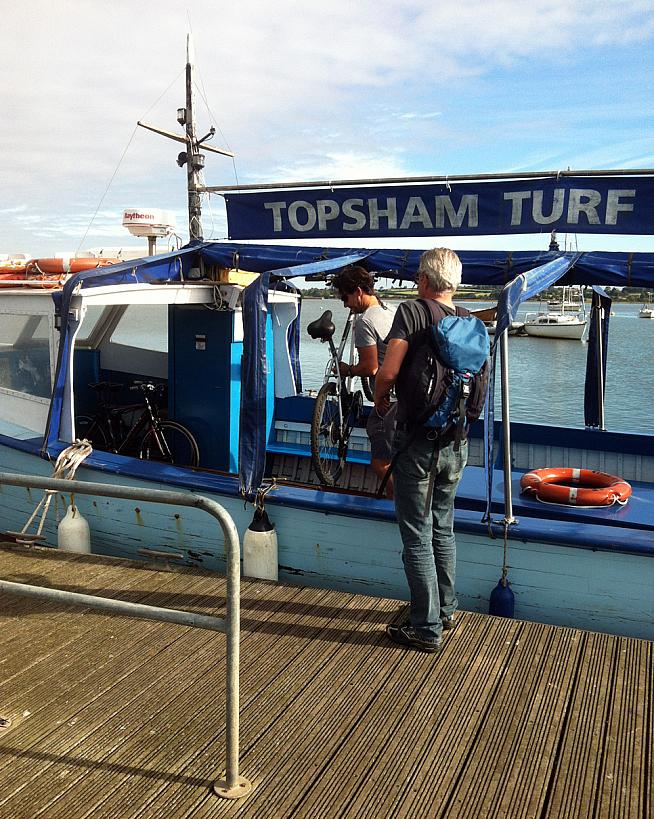
The route out of Topsham follows an excellent section of cycle track, with newly built boardwalks over the confluence of the Exe and the river Clyst - the estuary a haven for local and migratory birds and other wildlife. Lympstone, our lunch destination, is also famous for being the site for the Royal Marine Commando training base, and you pass by the assault courses they use just before coming to the town itself.
At Topsham we duly mounted a swift and decisive assault on a buffet lunch with more local meats and cheeses, and then, all too soon, the tour was at an end. We left our bikes in the hands of the locals, piled back into the minibus and on the drive to Bristol airport we bade farewell to our European companions and to our local hosts.
A tour for the people
The Tour de Manche is an ambitious project, but its success is not dependent on tourism. Given the boost in popularity in cycling over the last few years, many local people have benefited, both in and out of season, from having a well signposted, properly maintained cycle network. Sustainable travel is a bonus of this investment and it was obvious that the happy coincidence of stunningly beautiful countryside and reusable, abandoned infrastructure (thanks to the demise of local railway routes) enabled the project to succeed where some others may have failed.

Nervous or first-time cycle tourists will welcome the frequent and clear signage, and the sections of the route that we tackled were never intimidating or isolated. Everywhere we went there was a warmth and an enthusiasm about the project, which will hopefully endure with the arrival of many visitors in the years to come.
It was a new experience for me, too. My idea of cycle touring, up until now, was hopping from town to town on local main roads, as detached from the journey as any car driver. But the Tour de Manche is a different kind of cycle touring. The beauty of this kind of route is that it compels you to abandon those sterile highways and experience the countryside though gates and across bridges, down side streets and across meadows and woodlands.
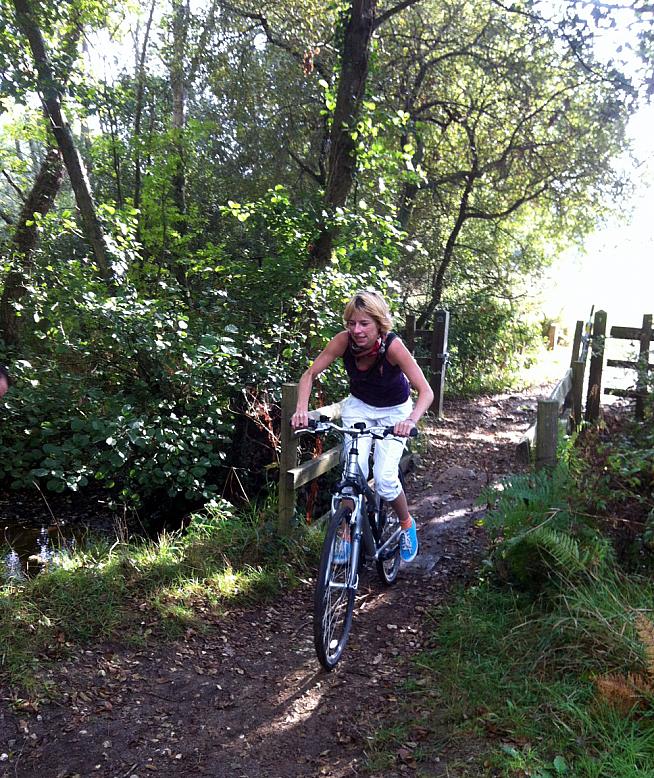
There are many options for riding the Tour de Manche. You can do as much or as little as you like: ride it alone or with friends, simply following the maps and excellent signage, or choose to have the whole trip organised for you by one of the many travel firms that can cater for all your needs - or any variation in between. Companies like Abicylette and Signpost Cycling offer tailored packages and consultancy services to allow you to be as adventurous as your budget or mood allow.
If you're more into a sportive kind of cycling, travelling light and fast, then these companies are also happy to offer a service helping you to find cycle-friendly places to stay and to transport any essentials from one stop to another. It's worth noting that the road surfaces are not always paved, so skinny tyres beware. But bring a cyclocross/gravel bike, a hybrid or a tourer and you're all set - with 1200km of cycleways to explore, there's enough to keep you busy for a couple of weeks at least.
However you choose to approach it, the Tour de Manche offers cycle-friendly access to the varied scenery, culture and cuisine of the coastline and islands surrounding the English Channel. It's an excellent initiative and well worth a look. Just remember to pack light or, like me, you may find those hotel stairs a challenge after a long day's indulgence...

1 Comments

